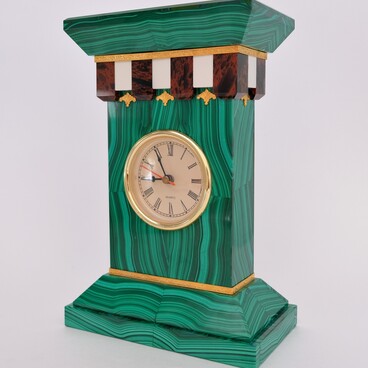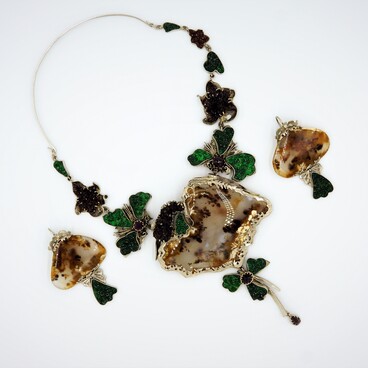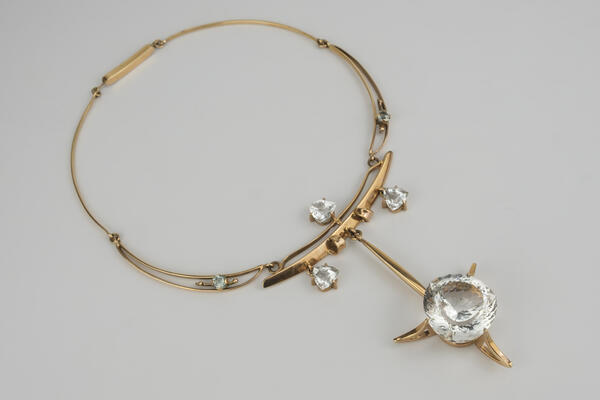The necklace-torque “Amethyst rain” was created in 1992 by Leonid Ustyantsev, one of the founders of the Ural Jewelry School. A big amethyst, which adorns the central part of the item, was found at the famous Vatikha deposit in the Urals. Another nine smaller amethysts are mounted along the rim of the necklace: six of them are round and three — oval.
The central stone is surrounded by silver plates with mother of pearl inlays. Long, thin pendants are attached to them from below. With the slightest motion, they rustle and make a quiet ringing sound.
The necklace was displayed at the first exhibition of the Museum of Stone-Cutting and Jewelry Art History which took place in 1993. Its name “Amethyst rain” was suggested by one of the visitors.
Amethyst is a variety of quartz which is usually purple, bluish-red or pale pink. Transparent amethysts are considered to be semi-precious stones and opaque ones — ornamental stones. In nature, this mineral is found in the form of elongated crystals. In the Urals, amethyst is mined within the so-called “semi-precious strip” of the Urals — in the heads of Neyva, Rezh and Aduy Rivers.
The creator of the “Amethyst rain” Leonid Ustyantsev was born in the village of Bagaryak, Chelyabinsk Oblast. In 1951, he graduated from the Sverdlovsk College of Industrial and Applied Arts №42, and then worked for 15 years at the Sverdlovsk Jewelry and Stonecutting factory. He simultaneously graduated from the Artistic Industrial School named after I. Shadr. Ustyantsev’s works were presented at the All-Union exhibition “Art and Everyday Life” in Moscow, as well as at several foreign ones — in Genoa, Paris and Tokyo. Leonid Ustyantsev even got a Grand Prix in France for his brooch “Caucasus”. This event opened the door for Ural jewelry to the international market.
In 1965, Leonid Ustyantsev was accepted into the Artists' Union of the USSR. A year later, was hired as an artist-jeweler at the Smolensk Diamond Factory. Among other works, he created items for a permanent exhibition of the USSR Diamond Fund.
In 1969, Ustyantsev returned to Sverdlovsk (presently — Yekaterinburg), where at first he worked at a jewelry factory and then at a creative production plant under Sverdlovsk branch of the Artists’ Union. In 1981, the first personal exhibition of Leonid Ustyantsev was held, and ten years later he was awarded the title “Honored Artist of the Russian Soviet Federative Socialist Republic”.
The central stone is surrounded by silver plates with mother of pearl inlays. Long, thin pendants are attached to them from below. With the slightest motion, they rustle and make a quiet ringing sound.
The necklace was displayed at the first exhibition of the Museum of Stone-Cutting and Jewelry Art History which took place in 1993. Its name “Amethyst rain” was suggested by one of the visitors.
Amethyst is a variety of quartz which is usually purple, bluish-red or pale pink. Transparent amethysts are considered to be semi-precious stones and opaque ones — ornamental stones. In nature, this mineral is found in the form of elongated crystals. In the Urals, amethyst is mined within the so-called “semi-precious strip” of the Urals — in the heads of Neyva, Rezh and Aduy Rivers.
The creator of the “Amethyst rain” Leonid Ustyantsev was born in the village of Bagaryak, Chelyabinsk Oblast. In 1951, he graduated from the Sverdlovsk College of Industrial and Applied Arts №42, and then worked for 15 years at the Sverdlovsk Jewelry and Stonecutting factory. He simultaneously graduated from the Artistic Industrial School named after I. Shadr. Ustyantsev’s works were presented at the All-Union exhibition “Art and Everyday Life” in Moscow, as well as at several foreign ones — in Genoa, Paris and Tokyo. Leonid Ustyantsev even got a Grand Prix in France for his brooch “Caucasus”. This event opened the door for Ural jewelry to the international market.
In 1965, Leonid Ustyantsev was accepted into the Artists' Union of the USSR. A year later, was hired as an artist-jeweler at the Smolensk Diamond Factory. Among other works, he created items for a permanent exhibition of the USSR Diamond Fund.
In 1969, Ustyantsev returned to Sverdlovsk (presently — Yekaterinburg), where at first he worked at a jewelry factory and then at a creative production plant under Sverdlovsk branch of the Artists’ Union. In 1981, the first personal exhibition of Leonid Ustyantsev was held, and ten years later he was awarded the title “Honored Artist of the Russian Soviet Federative Socialist Republic”.


